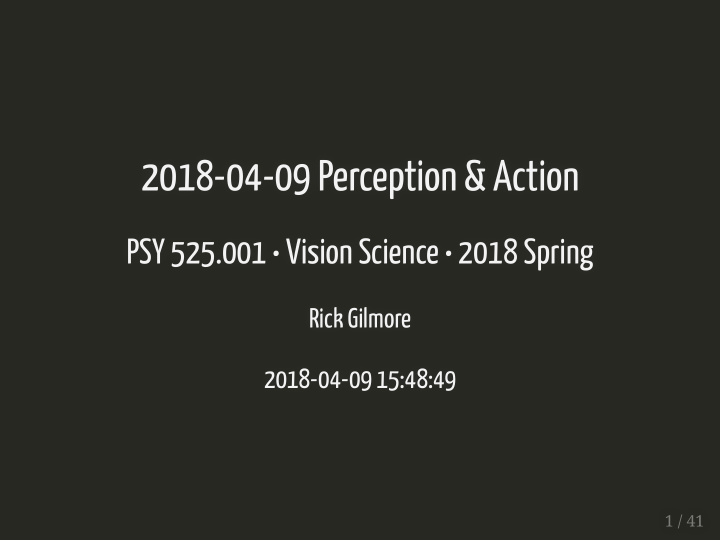



2018-04-09 Perception & Action PSY 525.001 • Vision Science • 2018 Spring Rick Gilmore 2018-04-09 15:48:49 1 / 41
2 / 41
Prelude 3 / 41
Prelude Student presentations start next week (Jackie, Ryan, Sara) 3 / 41
Prelude Student presentations start next week (Jackie, Ryan, Sara) Russ Poldrack talk Wed 4p 108 Wartik 3 / 41
" I don’t think we know what ‘attention’ is. It’s a concept that’s so broad and over-used as to be meaningless. There’s lots of things people in psychology and neuroscience study that they call ‘attention’ that are clearly different things. " Russ Poldrack Goldhill, O. (2018, April 7). Psychology will fail if it keeps using ancient words like “attention” and “memory.” Quartz . Retrieved April 9, 2018, from https://qz.com/1246898/psychology-will-fail-if-it-keeps-using-ancient-words- like-attention-and-memory/ 4 / 41
" We need scientific language, not a folk language. " Russ Poldrack 5 / 41
Today's topics Perception & Action 6 / 41
Gibson, J. J. (2014). The Ecological Approach to Visual Perception: Classic Edition . Psychology Press. Retrieved from https://market.android.com/details? id=book-8BSLBQAAQBAJ, chapters 12-14. | PDF |. 7 / 41
Looking with the eyes and head 8 / 41
Movement type Traditional view Gibson's view Fixation "Pointing at" Fixations rare Saccades Move target to fovea Part of scanning sequence Pursuit Track moving target Vergence Related to fixation Detect match and mismatch 9 / 41
" The function of the retina is to register invariants of structure, not the points of an image. " Gibson 1979, p. 217 10 / 41
" A visual fixation is not at all comparable to a snapshot, that is a momentary exposure. The eye has no shutter...The false problems stem from the false analogy between photography and visual perception that everyone has taken for granted... " Gibson 1979, p. 220 11 / 41
" The error was to suppose in the first place that perception of the environment is based on a sequence of discrete images. If it is based on invariance in a flow of stimulation, the problem does not arise. " Gibson 1979, p. 221 12 / 41
What is perception for? 13 / 41
Psychological space is made of up overlapping surfaces. We perceive events not time. We perceive (directly) the functions that objects serve for action (a�ordances). 14 / 41
" The theory of affordances implies that to see things is to see how to get about amongst them and what to do or not do with them. If this is true, visual perception serves behavior, and behavior is controlled by perception...Moving from place to place is supposed to be 'physical' whereas perceiving is supposed to be 'mental', but this dichotomy is misleading. Not only does it depend on perception but perception depends on locomotion inasmuch as a moving point of observation is necessary for any adequate acquaintance with the enviornment. So we must perceive in order to move, but we must also move in order to perceive. " Gibson 1979, p. 223 15 / 41
Support Obtacles vs. openings/apertures Direction and speed of self-motion Contact with surfaces Bene�t or injury ahead 16 / 41
Rules for... 17 / 41
Visual control of locomotion 18 / 41
Standing Starting, stopping, going back Steering Approaching 19 / 41
Entering enclosures Keeping a safe distance 20 / 41
Rules for the visual control of manipulation 21 / 41
Reaching Aiming Throwing Tool-using... 22 / 41
A task you care about and study in your research... 23 / 41
Break 24 / 41
Costall, A. P. (1984). Are theories of perception necessary? A review of Gibson’s The Ecological Approach to Visual Perception. Journal of the Experimental Analysis of Behavior , 41 (1), 109–115. Wiley Online Library. Retrieved from http://dx.doi.org/10.1901/jeab.1984.41-109 25 / 41
What is Gibson's 'beef' with cognitive psychology? 26 / 41
Can cognitive psychology be fairly characterized by an appeal to "internal, 'mental' rules and representations"? 27 / 41
In what sense is cognitive psychology "dualist"? 28 / 41
" Perceptions are constructed, by complex brain processes, from fleeting fragmentary scraps of data signalled by the senses and drawn from the brain's memory banks themselves snippets from the past. On this view, normal everyday perceptions are not part of-or so directly related to-the world of external objects as we believe by common sense. On this view all perceptions are essentially fictions; fictions based on past experience selected by present sensory data. (Gregory, 1974, p. xviii) " Costall, 1984, pp. 110 29 / 41
Is perception illusory, �ctional? 30 / 41
Is the environment full -- and must be '�ltered' -- or is the environment full because it o�ers perceivers many possibilities for action? 31 / 41
Organisms exist within the environment not outside it. 32 / 41
" This view of environment as causally prior to, and ontologically independent of, organisms is the surfacing in evolutionary theory of the underlying Cartesian structure of our world view. The world is divided into causes and effects, the external and the internal, environments and the organisms they 'contain'. While this structure is fine for clocks, since mainspring move the hands and not vice versa, it creates indissoluble contradictions when taken as the meta- model of the living world. " Richard Lewontin (1982) quoted in Costall (1984, p. 113) 33 / 41
Does vision science/cognitive science need behavior? 34 / 41
Krakauer, J. W., Ghazanfar, A. A., Gomez-Marin, A., MacIver, M. A., & Poeppel, D. (2017). Neuroscience Needs Behavior: Correcting a Reductionist Bias. Neuron , 93 (3), 480–490. Retrieved from http://dx.doi.org/10.1016/j.neuron.2016.12.041 35 / 41
36 / 41
37 / 41
38 / 41
39 / 41
40 / 41
Slides created via the R package xaringan . Rendered HTML and supporting files are pushed to GitHub where GitHub's 'pages' feature is used to host and serve the course website. 41 / 41
Recommend
More recommend